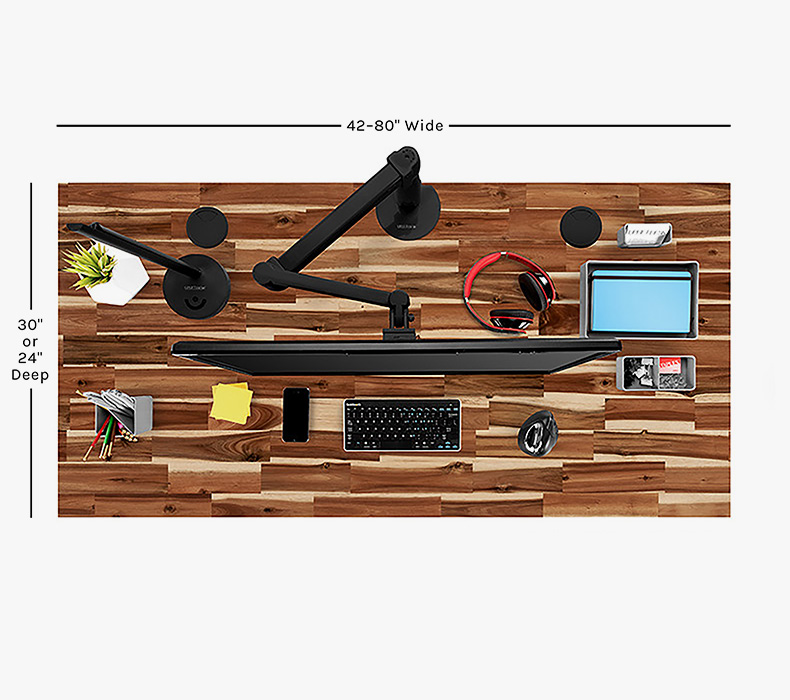
How to Choose the Perfect Standing Desk Size: A Closer Look At Dimensions
At this very moment, millions are working at desks that actively sabotage their potential. Of all the factors that make up a productive workspace, one critical element is consistently overlooked—desk size. Choosing the right desk dimensions is key to comfort, productivity, and long-term well-being.
Understanding Desk Measurements
Let’s break down the essentials. The average height of a desk ranges from 28” to 30”, but traditional fixed-height desks don’t accommodate everyone. Modern standing desks, like UPLIFT Desk models, break these former limitations with precision height adjustability. UPLIFT Desk frames adjust vertically from 22.6" to 50.9" using whisper-quiet motors and a 355 lb lifting capacity. This ensures the perfect ergonomic support for users ranging in height from 5' to 6'9".
The depth of your desk determines how much you can reach, how far back your monitors can be placed, and how much room you have on your desk. A desk depth of 24" to 30" is ideal, allowing an ideal ergonomic reach zone, eliminating unnecessary movements that silently deplete physical energy throughout an 8-hour workday. Learn more about optimizing your setup on our Benefits of a Standing Desk page.
Health Risks of Incorrect Desk Dimensions
Poor desk dimensions don’t just cause discomfort—they can lead to long-term health issues.. Improper desk height forces unnatural postures, leading to chronic back pain and musculoskeletal disorders. If a desk is too shallow, it can create awkward wrist positions during typing, dramatically increasing carpal tunnel syndrome risk while causing visual strain from suboptimal monitor positioning.
According to studies from the Cochrane Library, ergonomic positioning plays a crucial role in treating CTS through workplace modifications. The BMJ Open Ophthalmology report further notes that improper viewing distances can result in eye strain, reducing focus and causing persistent headaches.
The consequences of poor desk setup extend far beyond temporary discomfort. Musculoskeletal disorders (MSDs) among office workers represent a global health challenge, impacting both individual wellbeing and workplace productivity. Research from Malaysian Journal of Medical Science, emphasizes the importance of proper workstation habits in mitigating musculoskeletal disorders (MSDs). The research found that ergonomic interventions, including adjustments to workstation components such as desks, led to significant improvements in musculoskeletal health. Specifically, the study reported a substantial reduction in MSDs in the neck region among participants who received ergonomic training.
The right desk setup isn’t just about comfort—it’s a long-term investment in your health.

Key Factors in Selecting Desk Measurements
When selecting a desk, consider your workspace, monitor setup, and future needs. Available floor space is always a leading consideration for any workspace, so make sure to measure your available area.
The monitor setup, whether single, dual, or multiple displays, significantly impacts the required desk width. Storage space for office supplies and documents, along with room for monitors, speakers, and other peripherals contributes to creating an efficient workspace. Planning for potential upgrades, such as additional monitors or specialized equipment, ensures the desk remains suitable as work requirements evolve.
- 42-48" x 24" - Perfect for small spaces/apartments or offices that double as your bedroom.
- 48-60" x 30" - A standard small office size with enough depth for dual monitors or a laptop-plus-monitor setup.
- 60" x 30" - The most standard desk size, offering a balanced workspace.
- 60-72" x 30" - Great for multitaskers, allowing space for multiple monitors, notebooks, or other work task-stations so you can multitask without rearranging.
- 72-80" x 30" - The ultimate workspace, and what we use at the UPLIFT Desk offices! Six full feet or more of width and the full 30" depth is perfect for those who can't have enough desktop real estate to stay productive and organized.
Standing Desk Purchase Checklist
Before you buy, make sure your new desk fits your space and workflow. This checklist covers essential considerations for optimal desk selection that maximizes efficiency and comfort.
| Space & Dimensions | Usage Requirements | Ergonomic Factors | Workspace Integration |
|---|---|---|---|
|
|
|
|
|
Your Next Steps
The research is clear: desk dimensions significantly impact daily productivity and long-term wellbeing. Ready to upgrade?
➡ Browse our standing desk collection to find your perfect fit.
➡ Have questions? Chat with our ergonomic specialists for expert guidance.
Choosing the perfect desk is decided by unique needs and style. While features and accessories matter, by using our Standing Desk Checklist you can ensure your workspace will support your daily activities and reflect your personality. The right desk creates an environment that's designed to support your needs and enhances how you interact with your environment.